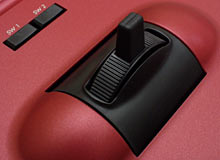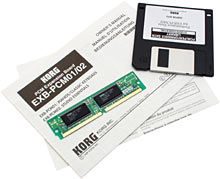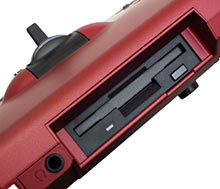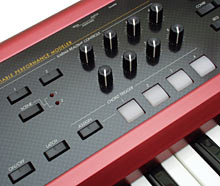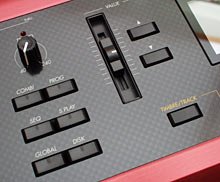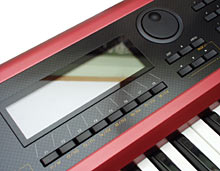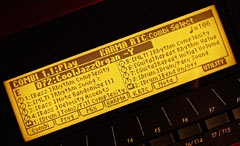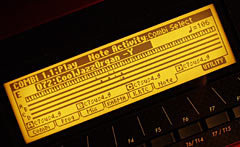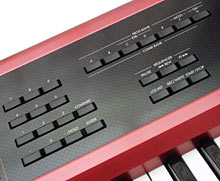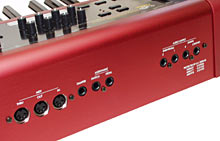
Korg Karma music workstation
Review date: 3 March 2002.Last modified 03-Feb-2012.
I've got to say, I really pity music store employees.
Now, no sooner have they unloaded two barrels of buckshot into someone who came in, picked up a guitar and started playing Stairway to Heaven very badly in complete disregard of the sign on the wall, than they'll have to reload while climbing the stairs to dispatch the guy in the keyboard department who's just started pumping out a storming club-anthem version of House Of The Rising Sun.
Or maybe even Chariots Of Fire.
The Muppets Theme is not out of the question.
Or, heck, Stairway. Or Smoke On The Water.
The latest piece of technology to enable such aural transgressions is Korg's Karma synthesiser. But it can do a very great deal more than just behave as glorified "auto-accompaniment". And you can also use its powers for good.
Auto-accompaniment technology has a very bad reputation. And, generally speaking, it bleeding well deserves it.
Among keyboard players, it's generally accepted that anything that has a button marked "Bossa Nova" on it is going to make noises that only certain people enjoy. Some keyboards now exist that make auto-play functions less than totally dorky, but they're rare, and tend to clamp the player into the BOOM-tisha BOOM-tisha musical genre.
There's nothing inherently wrong with the notion of an electronic musical instrument that can do things in response to what the player's doing - pick the chords and play a drum and bass accompaniment, or weave a widdly-widdly Too Many Notes filigree around the melody, or do all sorts of other clever stuff. Automated composition and performance aids have been around for some time. Lots of synthesisers have "arpeggiators" that can do considerably more than just break up a chord into pseudo-strummed separate notes, and MIDI sequencers and other postproduction tools are replete with such tools, too. A basic sequencer feature, for instance, is the ability not only to "quantise" your recorded performance into something that sticks more accurately to the time signature you choose, but also to "humanise" perfectly-timed sequenced tracks, to knock around their amplitude and timing a bit and make them sound more like something generated by an organic being.
The most extreme level of artificial assistance is full digital algorithmic composition, where a computer creates the whole tune from start to finish.
Full-blown algorithmic composition can sound melodious enough, but boring; very advanced wind chimes. Or it can sound like a jam session for musicians who each have only a four-second short-term memory. Or it can sound like a symphony composed by an autistic Martian. For much the same reasons that computer grammar checkers have only a very stylised concept of context, it's difficult to make an automatic composer that can be inventive without wandering off into mystifying weirdness.
But a clever enough algorithmic composition system can get around this, by using a human to direct it through infinite musical space. With any luck, the human will have some idea of what sounds good; that's a really difficult thing to teach a computer.
A side-effect of this is that it becomes possible to make a really flexible instrument that can make a really wide number of interesting sounds, and do it live. One person with one keyboard can play a full multi-part piece, without having to pre-record or post-edit anything. This assumes a fairly loose definition of the word "play", of course. More on that later.
Anyway, just such an instrument now exists. The Karma came out last year, and I've got one.
The Karma is, in essence, a Korg Triton workstation with several high-end features deleted and synth geek Stephen Kay's KARMA algorithmic-composition-with-icing-on-top system added. KARMA, the system, is different from Karma, the synthesiser; the name of the system gets capitalisation because it stands for "Kay Algorithmic Realtime Music Architecture".
KARMA is an impressively flexible MIDI-based note creator and modifier, which can do everything from full press-one-key-and-walk-away algorithmic jamming to very subtle twiddling of an otherwise completely human performance. There's a big description on the KARMA Lab site here, which is about as good as anything I could write, and which doesn't seem to have been whacked too hard with the public-relations stick.
In essence, the KARMA system does everything that every auto-accompaniment keyboard's sales brochure said it could do. It can also do tons of stuff that no previous plays-itself-for-you instrument ever even pretended to do.
The Karma is, at this moment, arguably the best show-off synth in the world.
And it looks it. Granted, the Karma doesn't have the totally over-the-top Star Trek styling of some synths slanted towards live performance. But its case (steel base, aluminium top, plastic ends) is burgundy-red, its black control panel has a twinkly woven carbon fibre finish, and it's got a pretty respectable complement of knobs, as well as the usual expanse of buttons.
But it's suspiciously cheap.
This thing's got Triton sounds. It's got Triton effects. Yet it's got a list price of $US2250, while the Triton Rack module (synth without keyboard) lists for $US2495, and the 61 key Triton's $US2995. The street prices for all of these are a lot lower; electronic musical instrument pricing has all the economic stability of a Bombay flea market. But the ratio's the same - the Karma costs about three quarters as much as a Triton with the same size of keyboard.
(Korg have, by the way, recently released two models of "Triton Le", which have many of the Karma's design compromises and no KARMA feature. The 61 key Triton Le is cheaper than the Karma, and ought to save people who don't actually care about KARMA from having to buy a Karma anyway.)
One reason for this is that the 61-key Karma keyboard itself is a rather underwhelming unit, with clunky, somewhat buzzy keys. They probably won't break, but they sound as if they will. This keyboard is not a joy to play on; it's got velocity and aftertouch sensitivity (how hard you hit the note, and how hard you push on it after you depress it), but so does everything half-decent these days, and that's the end of the list of its good features.
My Fatar Studio 900 controller keyboard (a controller keyboard is just a MIDI event generator, which has no on-board synth capabilities of its own) is a full 88 note weighted 'board with far nicer feel (but no aftertouch). Anybody who wants to do "serious" playing on a synth with as crummy a built-in keyboard as the Karma is likely to want a similar outboard controller.
Then again, the Fatar keyboard weighs about twice as much as the Korg. The Karma only weighs 10 kilograms (22 pounds), plus power supply brick and any pedals and cables you're toting with it. It's not big, either; only 1100 by 320 by 119mm (43.3 by 12.6 by 4.7 inches). If you have to carry a keyboard around, you can forgive it a lot of sins if it's relatively light and small.
Still on the input side, the Karma also lacks the Triton "ribbon controller", a useful programmable analogue controller that works in the same way as a laptop touchpad, but can be set to do all sorts of modulation tricks. Or, on the Karma, can't, because it's not there.
The Karma does have a joystick controller, which does the usual X-axis-bend and Y-axis-modulation tricks, but can do other things depending on the sound you're using. Lead guitar sounds can go to tremolo when you push the stick forward and go to overdrive when you pull it back, for instance, and almost all of the Karma/Triton tonewheel organ sounds let you turn the Leslie rotary speaker effect on and off by pushing the stick forward.
MP3 example
The demo MP3s in this article are all completely un-sequenced, and most of them are the first take, too. This is partly a result of my personal laziness, but I also did it because it lets you hear what the Karma actually sounds like when it's played live by someone who's an all-right keyboardist, but nothing special.
Killerb.mp3 shows off one of the Karma's quite convincing tonewheel organ sounds, without any fancy KARMA effects. You'll hear the point where I turn on the rotary speaker effect with the joystick.
The two buttons above the stick are on/off toggles (with status LEDs), and they're also highly programmable.
Above those two buttons are four knobs, which I'll get to in a minute, and the PCM expansion board bay. The Karma/Triton synth engine is PCM (Pulse Code Modulation) based; all of its sounds are built, at the bottom level, from samples. This doesn't, for the benefit of people who don't know synth jargon, mean this thing is, or has, a sampler; you can't record your own audio clips on it. The Triton synths do have a sampler, but that's another of the things that's been left off the Karma.
I got a "Studio Essentials" expansion board with my Karma; it adds a slab of extra sounds, and there's still space for one more PCM board. The Karma can also accept a MOSS (Multi-Oscillator Synthesis System) physical modelling expansion board, in a bay on the bottom of the keyboard.
The knobs below the top expansion bay are real-time controls that aren't connected to the KARMA system. The button next to them changes their mode. In one mode, they do analogue-synth-style adjustment of Low Pass Filter (LPF) cutoff, resonance level/High Pass Filter (HPF) cutoff, and Envelope Generator (EG) intensity and release. In the other mode, they're programmable, and can do all sorts of things.
My expansion board, and the documentation and floppy disk it comes with.
Well, Korg call it a "board". Looks like a freakin' memory module to me.
When you install the expansion board, the synth automatically gets access to all of the PCM data it contains, but that data is just the building blocks of actual voices; you need a pile of tone parameters as well if you want to use the new sounds. It's possible to enter all of this stuff manually, of course; that's exactly what you do if you're building a new voice from scratch.
But that's not what you do after installing your new expansion board. This is where the floppy disk comes in.
The Karma, like the Tritons and lots of other "music workstations", has a floppy drive which can read and write standard MS-DOS format disks. Expansion boards come with a disk containing tone data for all of the contents.
Floppy disks are the only permanent storage the Karma has for tunes. It's got a built-in sequencer, like the Tritons, but it has no on-board memory to store sequences when it's turned off. All of the Karma's instrument data is remembered, of course, but you need to re-load any sequences from floppy when you turn the machine back on. This is a bit disappointing for something that calls itself a "music workstation".
You can, by the way, easily use the Karma as a boring old MIDI file player; it's fully General MIDI Level 2 compliant, so when you and the Magictones finish "Quando Quando Quando" you can use the Karma to play the easy listening version of "Just The Way You Are" while you talk to your disreputable fellow musicians.
To the right of the expansion bay area is the Karma control bank, the four chord buttons, and the volume slider.
The KARMA controls only do anything when the KARMA system's turned on with the inventively named "ON/OFF" button; if the Latch button's also on, then the keyboard keeps doing its thing even when you're not touching any keys, as it works from the last notes you played.
MP3 example
Want to hear the KARMA system being a mere arpeggiator? Check out kaleido.mp3. I think you'll notice the moment when I turn KARMA on.
And then there's hbend.mp3, in which the arpeggiator-ish effects are a bit further separated from the actual chords I'm playing on the synth sound in the middle of the mix.
The eight KARMA Realtime Control knobs and the 1 and 2 buttons to their left do different things depending on what KARMA "Generated Effects" (GEs) are being used for the current voice. GEs are the basis of the KARMA system; there are 1190 of them to choose from. To give you some idea of how much more the KARMA system can do on top of arpeggiator functions, there's a full complement of arpeggiator GEs. A whole 33 of them.
You can have up to four GEs working at once in a multi-timbral "combi" voice (multiple single-timbre Program sounds together, with or without the Program's effect settings), with functions toggled on the 1 and 2 switches, and the knobs changing any eight of the modifiable parameters in real time. The keyboard only lets you modify 16 of the more-than-400 parameters of each GE, but there are so darn many GEs to choose from that this really isn't much of a limit. And outboard software's promised that'll remove even that limit, and let you create your own GEs from scratch as well.
In use, the knobs commonly tweak things like rhythm complexity and "swing" (syncopation), the range and scale and complexity of melodic effects, the level of various components of various sounds (want to only turn up the snare drums in the rhythm track? No problem), the behaviour of effects like gating, and... well, and lots of other stuff.
The knobs aren't motorised; they don't automatically move to match whatever position is appropriate for the value of the thing they control for a given voice. The appropriate screen display modes, though, let you see the approximate knob position for each knob, and invert the little on-screen knob's colour whenever a knob's not on that position. Whenever you move a knob, you're setting whatever it's controlling to the value of its position now. The Karma ignores knob and slider positions until you move them.
There's also a "Scene" button, which switches between two different KARMA control setups, so you can have one bunch of settings for the verse and another for the chorus, or one for the groove and another for the bridge, and so on. This isn't a full auto-accompaniment live-arranger function, though; there are no simple friendly buttons marked Intro, Verse, Chorus, Fill and End.
The white chord buttons under the main KARMA controls serve three basic functions.
MP3 example
Buttondemo.mp3 shows off what you can do if you're lazy and perform your whole left hand part with the stock-chords white buttons.
Sometimes the stock chords make very clear the intended musical-joke purpose of a novelty combi. Like the "Heroic Scene" combi, for instance: hscene.mp3.
First, and most simply, they let anyone look like a keyboard virtuoso. Until the audience cottons on, anyway. Every voice that's got KARMA data will have four appropriate chords of up to eight notes pre-assigned to the chord buttons, and pressing the four of them in order with KARMA turned on and some vague sense of rhythm will probably cause the synth to play something that sounds quite spiffy.
Second, the buttons let you hear what the creator of a given patch was thinking when he created it. This is handy for the weirder combis; a few of them require you to play in a quite unnatural way (silent left hand "guider" chords, relative rather than absolute right hand notes...) to work properly. Most of the Karma's patches make no such demands, but it still doesn't hurt to be handed a jumping-off point.
Third, the chord buttons are a useful tool for someone who's only got one hand free yet wants to tell the Karma to play something complex. It's easy to re-assign each of the buttons to any up-to-eight-note chord you want. I wouldn't have minded a couple more buttons, but they're useful as is.
Oh, yes. When you press them, they light up.
To the right of the KARMA controllers are the Tempo knob, the multi-function Value slider and pair of single-increment buttons, the Timbre/Track shift key for editing functions using the buttons under the screen that we'll get to in a moment, and the six basic function buttons that let you put the Karma in one mode or another.
The first mode is Program, in which you're playing just one timbre and can have only one KARMA GE attached to it. Then there's the multi-timbral Combi mode, which ties multiple Programs together. There's Sequencer mode, in which you're working with the Karma's built in 16-track sequencer; an outboard sequencer (a standalone unit, or a computer running sequencer software) is easier to use, though. There's also a Sequence Play mode for easily playing songs from floppy, a global settings change mode, and a general disk mode that lets you load and save songs and synth settings, format disks, and so on.
The amber-backlit LCD screen is next, with eight function buttons under it which line up with the changing menus in the different modes. There are general navigation controls and a multi-function jog wheel to the right of the screen.
The screen is another place where the Karma cuts corners compared with the full-spec Tritons (not the Le models). The Tritons have a 320 by 240 pixel touch-screen; the Karma's got a lousy 240 by 64, without touch sensitivity. This makes a big difference for fiddly sequencer tasks, and also means that doing full 400-parameter GE editing in the Karma would be pretty darn irritating. Which is a big part of the reason why you can't.
The relatively poky Karma screen squishes lower-case letters in the smallest font size down to only four pixels in height. Given that, it's surprising how legible text still is; the letter S looks weird (with a little hole in the middle), but it really doesn't suck that badly. At least twice the resolution would still be nice, though.
Here's the screen showing the KARMA Real Time Controller display, in Combi mode. This is the what-do-the-knobs-do screen.
Here's the Note display, showing what notes are sounding - which, if KARMA is turned on, probably isn't the same as what keys you're pressing - and what chord each KARMA module thinks you're playing, according to the section of the keyboard it's been told to monitor. This display's not terribly useful most of the time, but it's a good audience impresser.
The Mix display, though rather cramped, is more handy. It shows the pan and level of each part of a combi in real time, so you can see pan values jumping around when GEs tell them to, and you can easily turn parts up and down, assign parts to internal voices or external sound modules, and so on.
To the right of the screen are all of the boring sound select and bank select and sequencer control buttons.
The full-spec Tritons have audio inputs, so you can use their effects on other sounds. They also have a SCSI expansion option, so you can connect them directly to serious storage. In another cost-cutting measure, though, the Karma just gives you MIDI In, Out and Thru, a couple of stereo 1/8th inch phono line level outputs, and inputs for a damper pedal and two more assignable pedals. No digital audio out or in, I'm afraid.
The MIDI connections may be minimal, but there's one very important thing about the Karma's MIDI capabilities. All of the Karma trickery is done with perfectly normal MIDI messages. And all of that MIDI data can be output to external devices. So you can record a full Karma-ised performance on an outboard sequencer - you won't be able to play it back properly on non-Karma-capable hardware if it relies on effects that the Karma has and your other hardware doesn't, but all of the normal note data is playable anywhere.
You can also play the Karma in real time from another keyboard, in two ways. Input on whatever MIDI channel's set in Karma's global MIDI configuration menu (channel 1, by default) is treated like input from the Karma's own keyboard. If you want to play individual timbres in a combi, no problem; just change the MIDI channel you're transmitting to the Karma on to match the channel used by that timbre. Because of the all-MIDI way that Karma works, you can do this while playing the Karma's own keyboard, too. You can also filter out program change messages from the other keyboard, if you like.
You can turn off a Karma voice and have its place taken by an external module - heck, you can ignore all of the Karma's internal sounds if you want. Since each timbre in Combi mode can be either an internal or an external device, there's a problem if you want both at once. You can do it, though, if there are unused timbres. They may be turned off in that Combi and so not do anything with the synth's internal voices, but they can still have a MIDI channel assigned to them that's the same as one assigned to the timbre you want to double up, and then be told to drive an external device; bingo. Or you can just use the sequencer mode without recording anything; this workaround is also mentioned in the FAQ.
You can also take the output from an external sequencer or other MIDI-note-generating gadget, feed it to the Karma, use whatever GEs you like on it, and play the result with the on-board Karma voices or anything connected to the Out port.
All of the Karma knobs and switches can have their own MIDI CC messages assigned to them as well, so you can use them to control outboard hardware if you like, or just record your live control activity to an outboard sequencer for later playback through the Karma.
More MP3s
I know you're all just here for the l337 MP3z. I won't make you read the rest of the review hunting for them. Aren't I nice.
Check gnites.mp3 out. Random noodling while hunting for musical insight has never been so much fun.
Getting realistic guitar strumming out of a keyboard is tricky, particularly for a keyboard player like me who doesn't really have a lot of clue about what you can and can't physically play on a real guitar. I'm told that most guitarists can't even play more than six notes at a time. I don't know how they manage, I really don't.
Karma effects can certainly help, here. Guitarist.mp3 starts out without Karma assistance, then uses it to somewhat realistic effect.
If you find yourself needing to take an archetypal forbidden-in-guitar-shops chord progression and turn it into a self-important B-movie title track complete with pretending-you're-analogue pitch wobble, Karma can help you out. Example: nbelle.mp3.
As nightsky.mp3 shows, some of the Karma combis are sufficiently filled with filter-y MIDI trickery that just playing a chord, standing on the sustain pedal and sipping a refreshing beverage conveys the impression that considerable knob-twiddling is in progress. If you actually do twiddle knobs while holding the chord, things get even weirder - witness nightskytwiddle.mp3.
If Crimes Against Music are your thing, the Karma can readily commit melodic murder in any number of ways. The somewhat ragged assault upon a famous TV theme in nycwho.mp3 is a decent example. Jazz standards aren't safe, either; I'll be called to atone for summertime.mp3 after I die.
You can also get the stock MP3 demos from Korg's own Karma page here and the Karma Lab page here; Keyboard Magazine has lots of Karma demo MP3s here. Here, on MP3.com, a further collection of Karma tracks.
So wossit like?
I've been mucking around with the Karma for a while, now; I'm still really only dabbling with the editing side of things, but I've got a reasonable handle on the performance side.
The Karma's documentation isn't exactly a model of transparency, but that's not uncommon in synthesiser manuals. I think synth companies use the same technical writers who do docs for artillery pieces.
You don't need to pore over the manuals just to play the thing, though; that's reasonably straightforward.
The Karma's user interface continues a fine tradition in the keyboard world by having menus that are accessed in funny ways, configuration options that aren't obvious, peculiar event sequences, and various other features that suggest that we Earthlings have accidentally been given the firmware that was meant for plant people from galaxy M83. It's far from being a complete shambles, and you can get the hang of it without undue effort, but it's still weird.
The default ordering of programs and combis is also rather mystifying, with completely different sounds all jumbled up one after the other. Fortunately, there's a "select by category" feature that makes it quite easy to just page through the various permutations of one kind of noise.
Getting a decently together live performance out of the Karma isn't too hard. Without the "finish now" button that arranger devices provide, though, you have to learn to use the Latch switch, which is what tells the Karma functions to keep doing their thing when you're not playing anything. Whatever you played last is what Karma will keep riffing on, with Latch turned on.
Latch-on is what you want to play most grooves; it lets you sit on a chord, maybe noodling on a lead break, while you fool with other controls. When you want to end the piece, you just have to learn to turn Latch off when you're playing your final chord. Then, lifting off the keyboard won't result in an aimless cyborg accompaniment band dribbling on without you.
There's a really wide variety of standard combis, not all of which are actually useful for playing a tune. More commonly, though, you'll have some bass-y thing on the left hand with a rhythm track following it and some lead-y thing on the right hand with some pad or string wash behind it, and the Scene keys will switch between a full-pump suite of settings and a more restrained bridge set, and the four chord buttons will be preset to make a serviceable groove all by themselves if you're feeling lazy, and as a result you can just hop in and start playing. Commonly, the joystick and the SW buttons above it are set up to do usefully expressive things, as well.
The Realtime Controls knobs are more specialised and less likely to do anything palatable, but the B mode of the Realtime knobs is completely programmable, so sometimes they're all handy for something. And if they're not, you can of course change what they do.
The output from most of the more approachable Karma combis, if you don't bother to edit anything, sounds like nothing so much as the workaday background music from a demo. It's not necessarily doof material, though there is plenty of that; ambient soundscapes also abound, and many of the drum-driven combis can be ambient-ised easily by turning a couple of Karma knobs down.
If there doesn't happen to be a standard no-percussion tweak in a combi, it's easy enough to silence the offending voice in the Mix display. You can also go to the KARMA setup page, which lets you tweak the up-to-four GEs the combi uses, and select the "Solo" boxes for each of the things you want to hear. If anything has the Solo box ticked, only things with the Solo box ticked will sound.
There are a few one-finger-orchestra combis, where your first keyboard touch in Latch-on KARMA mode leads to both bass and lead meandering off on their own little groovy journey with no further need of input from you, and in which the playing of an actual chord generally leads to a useless mismash of notes. These patches are in the minority, though, and there's nothing stopping you from replacing them with something else. Every single Karma memory spot is a "user" location whose contents you can change or replace. There aren't any fixed ROM programs or combinations.
Generated Effects can't do everything, but they can do a great deal. They're broken up into four subcategories. "Real-Time" GEs do stuff with the notes you're playing; they're sort of like a hopped-up arpeggiator, which can do modulation effects as well as arpeggiation. "Generated Riff" GEs are the extension of this concept; they're the ones that can play whole pieces by themselves, or, more usefully, embroider on what you're playing in a variety of ways, up to and including producing output that's based on what you're playing, but doesn't actually contain any of the same notes.
"Drum" GEs are mainly made to play drum tracks, with or without improvisation; they give you patterns that can be looped and hooked together in different orders. They can be used with normal instruments as well - and are, in some of the weirder combinations.
"Gated" GEs do filter or volume or modulation tricks with the notes being played; basically, they generally sound like a fancy standalone smart filter box. Except it's all still just MIDI, and you can record it on your sequencer.
When a given KARMA setup really fits whatever you want to play, it doesn't feel like an auto-accompaniment system. It feels like four obliging robotic session players, who see exactly what you're doing and always match it, never making you wait while one or more of 'em figures out that you're playing F7 now and not Cmin.
KARMA doesn't, generally, entirely eat and reprocess what you're playing; if your left hand's controlling the bass and rhythm section, there's likely to still be a definite bass note in response to every keypress, noticeable in the mix among all of the other stuff. If there isn't, some editing should give you one. So the time you spent learning to do a plausible funk slap bass on keys doesn't have to be wasted.
Sounds
If you're looking for fat, thin, warm, cool, blue, green or ultraviolet synth sounds, the Karma has you covered. If it ain't there, you can probably make it. It's also strong in the Hammond organ department; it's not a proper dedicated organ module, and it's certainly not Native Instruments' outstanding B4 software organ simulator, but it's good enough for most purposes, with clean, dirty, nasty and pious tonewheel sounds awaiting you.
MP3 example
If you want giant layered filtered patches complete with I-meant-that-to-be-there clipping, Karma can oblige. Exwat.mp3 is a mere held chord played on one of many such patches.
Strings, brass, choirs and other orchestral acoustics aren't bad, but aren't going to set any records. The Studio Essentials expansion board I got adds quite a lot more of these, and they're OK for use in a multi-part tune (which, to be fair, is where you're likely to use them). But they're not so hot solo, if you ask me.
The Karma's piano sounds tend towards the electric-and-effected; if you want realistic acoustic piano, the "Pianos/Classic Keyboards" expansion board probably fills the gap.
It doesn't fill the pipe organ gap, though; my old Roland JV-880 module with Super Sound Set expansion board has several pipe organs that are all as good as or better than anything the Karma can offer. But you get a pleasing wall of sound if you mix a JV-880 organ with the Karma's best effort.
Guitars? Pretty good, though I'm still figuring out the modulation tricks to get better realism. Drum kits? Good, and numerous.
Even fully expanded, the Karma won't have The Only Sound Set You'll Ever Need. But even without any expansion, it'll do for any kind of music. You may just have to fiddle a bit, and put up with sub-optimal sounds here and there.
Religious issues
The arrival of the Karma in 2001 resulted in a certain amount of animated debate. And as usual, we got to hear primarily from the extremists.
On the one hand were the "Transcendence! My creativity has been unlocked! The colours! The colours!" super-enthusiasts.
On the other hand were the people who couldn't resist the urge to deconstruct the thing, and didn't like their conclusions. The KARMA-haters seemed to outnumber the KARMA-lovers considerably.
Some of the haters were of the opinion that KARMA spells the end of musicianship, because it makes everything too easy, encourages people to be lazy, stops them coming up with their own ideas by providing a constrained compositional universe, blah blah.
A more cogent argument against KARMA and other player-assisters is that they make it rather easy to crank out vast quantities of, well, crap. Take the default settings, play something from your second grade piano lesson book (or take three and a half seconds of Brian Eno and stretch it to last all night), press 50,000 copies, engage marketing machine, get rich.
Well, that's true. But people said the same thing about samplers, and they were right then as well, and it didn't matter much then, either.
Many not-very-talented people have created great steaming mounds of ordure which would not have existed without samplers. The world teems with briefly popular tunes about which the only good thing was the loop, nicked from a Genuinely Legendary Band, on which the flash in the pan top-40 track was built.
But that's just a manifestation of Sturgeon's Law - "90% of everything is crud".
Sure, lots of stuff made with samplers is rubbish. Lots of stuff made with Karmas will be rubbish. Lots of stuff made with screwdrivers is rubbish. If you don't like this, take it up with the universe. That's just how things work.
When samplers appeared, lots of people ripped off the Funky Drummer solo, laid a veneer of their own uninspired material down over it, and sold the result. But there weren't any large nasty men threatening consumers with splintery fence palings if they didn't buy that rubbish. The people that bought it, bought it because they thought it was worth the money. They didn't think it was rubbish. Welcome to free society, please enjoy your stay.
Never mind whether the evil venal record companies squished better music out of existence in order to push this pap, thereby preventing the unwashed masses from buying better stuff. Yes, they did, but you can't blame samplers for that. And you won't be able to blame the Karma and the other algorithmic composition widgets which will no doubt follow it for the similarly low-effort, low-creativity music that'll be created with them, and sold.
If you're a keyboard player of completely unremarkable ability - which I am - the Karma makes it easy for you to whack out hours on end of what sounds, to someone who hasn't heard a Karma before, like rather good and even quite inventive grooves. I don't see anything wrong with that, in and of itself.
Just because something's difficult doesn't make it worthwhile, after all. Does anybody out there feel a strong urge to climb Mount Everest naked?
OK, actually, someone probably does. But he doesn't pretend to be sane, so it's all right.
If some ordinary keyboard player has a Karma, and an appreciative audience, and a kidney-kicking PA making clear to everyone for half a mile that ongoing booty-moving is the order of the day, and everybody has a dance and has a good time, then where's the harm?
If the same person was just changing CDs all night, not many people'd call him a music-killing parasite, after all.
Now, if he pretends that the Karma's his own personal bedroom invention, or does a whole lot of meaningless hand-moving to give the impression that it's all his own work, that's different.
Nobody deserves to get paid a million bucks a year for standing in front of a crowd with a Karma and a couple of other gadgets and playing three chords a minute. That doesn't mean that some people don't occasionally manage to do something similar, for a little while, but the market generally self-corrects quickly enough and they sink back out of sight.
Overall
The Karma isn't brand new any more, but it's still one of a kind. And it's getting better; according to Karma Lab, a "Karma MW" package will be out shortly that'll let you do funkalicious things like edit every GE's internal parameters, create whole new GEs, convert standard MIDI files straight into GEs, and turn Triton arpeggiator data into GEs as well, thereby making Triton sounds work completely on the Karma without hand-recreation of their lost arpeggiator effects.
Karma MW will cost money (recent Karma buyers in the USA, and maybe elsewhere, will get it for free), but there'll also be free-download Karma effects to match the existing expansion boards, which will apparently do everything the Triton arpeggiator does, plus more. There's a new release of the Karma firmware on the way as well, with a pile of tweaks and bug-fixes. There's a press release about all of this here, as I write this.
The Karma isn't a jumped-up "home keyboard" designed to make the incompetent sound musical. It can sort of fill that role, with some of its stock combis, but there are lots of others that sound awful if played by someone unschooled in rhythm and melody.
This is a good sign; it means that this is an instrument, and not just a toy.
A toy it certainly is, though. A most excellent toy. A toy that is more than capable of causing you to feel the groove.
The standard Triton synth engine is a very good one, particularly if you're not trying to mimic a symphony orchestra all that often. The KARMA system is completely brand new, unlike anything else, and really really tweakable.
So if you're a techno-geek, and you can play keys with something that'll pass in a dim light for skill, and you'd like a very conceptually deep instrument with which to tinker endlessly, and you can afford a Karma (they're less than $US1600 on eBay, now), buy one.
You won't be sorry.
Sound On Sound magazine's excellent multi-perspective review of the Karma is online here.
Miles and miles of Harmony Central user reviews of the Karma are here.
Sonicstate.com has more user reviews, here.
People who aren't up on the technical jargon should check out the Beginner's Synthesizer FAQ.
Keyboard Magazine has a very good feature on everything KARMA here.
Intermusic.com's review is here.
For people who actually own a Karma, there are some free downloads on techno-id.ifrance.com here.

